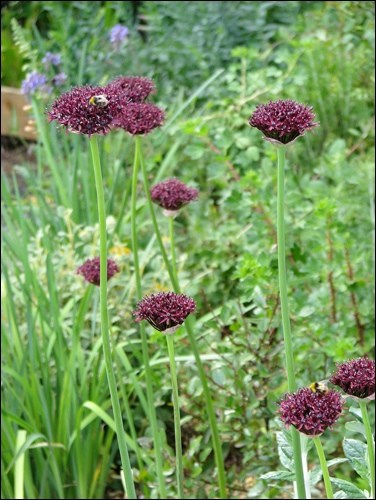Ornamental onions, generally known by its genus (Allium), are a diverse group of plants, several but not all of which are prairie hardy. Many of the taller and heavily advertised ornamental onions are simply not hardy through most of the region. While Allium giganteum may survive in a sheltered location, it’s not fully dependable. Its cultivars such as Gladiator and Globemaster are even less hardy. A. cristophii and A. neopolitanum should also be included in this category.
Among the more recent introductions to prairie Canada, is A. vineale Hair, a somewhat odd but very attractive ornamental onion in which produces a cluster of tiny purplish bulbils among which, and from which, erupt a profusion of fine green thread-like leaves, creating the illusion of a mop-head, hence the name. Thus far, it has proven hardy in Edmonton and is worthy of trial elsewhere.
New on the shelves, but thus far un-tested are two A. giganteum selections. Silver Spring has a large ball of white flowers, each with a purple white centre and a red wash along the central nerve of each petal. Drummer Boy (also called Summer Drummer) purports to be the largest A. giganteum yet, with purple flowered umbels reaching 45 centimetres of metre-tall scapes.
Less common hardy species worth trying:
A. atropurpureum (75-90 centimetres) has rich burgundy flowers that dry well.
A. obliquum (60 centimetres) greenish-yellow flowers in high doomed umbels in late June through mid-July.
A. schbertii (20-30 centimetres) is less hardy but worth trying in a protected spot because of its unique flower heads. Up to 50 soft lilac blossoms are borne on stalks of differing lengths. The umbel is up to 20 centimetres across and resembles a starburst of fireworks.
A. stellatum (25-35 centimetres), a prairie native with pink flowers, has become quite rare in the wild due to habitat destruction.
A. textile, another prairie native, is shorter (10-15 centimetres) with white or very pale pink blossoms.
A. carinatum has bell-shaped purple flowers in mid-summer. Although it produces bulbils among the flowers, it is not aggressively invasive.
A. zebdanense (20-25 centimetres), native to Lebanon with white bell-shaped flowers, has adapted well to prairie gardens.
A. siculum (more correctly Nectaroscordum siculum) (30-45 centimetres) bears pinkish, down-facing bells but needs a protected environment.
A. nutans, the steppe onion (45 centimetres), is grown as much for its foliage as for its flowers. The leaves are flat, about 2 centimetres wide, a glacous blue colour with two or three characteristic twists in each leaf. It has ball of lilac flowers 10 centimetres in diameter in early summer. Individual plants produce 40 to 50 flowering scapes and are very appealing in full flower. Be forewarned: it is a prolific seeder – deadheading is mandatory!
A. senescens is virtually identical to A. nutans in form, but has shiny, wax-like, deep green leaves and rose-purple flowers.
A. ramosum is also known as honey garlic. Tall at 75 centimetres , it produces clusters of white, very fragrant flowers in late June. While it sets seed and spread slowly, it is not aggressive.
A. tuberosum, widely known as Chinese or garlic chives, is very similar to A. ramosum, but blooms in September, lending late season colour and texture.
Foresgate is a lovely pink flowered selection of common chives (A. schoenoprasum). Deadhead as it readily crosses with the common form and produces only purple offspring. Divide the mother plant for additional pink-flowered chives.
Allan Daku is a Saskatchewan-born horticulturist, now retired and twice as busy as he was when he was working.
— This column is provided courtesy of the Saskatchewan Perennial Society (SPS) (www.saskperennial.ca; hortscene@yahoo.com). Check out our Bulletin Board or Calendar for upcoming garden information sessions, workshops and tours: Fall Lily Sale, The Mall at Lawson Heights (Saskatoon), Oct. 2, 3 [note: The funds raised through the bulb sale are used to provide two scholarships for students studying Horticulture at the University of Saskatchewan and a bursary for students studying Horticulture at the Olds College of Agriculture, Olds, Alta.]



